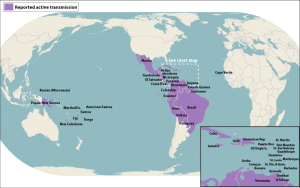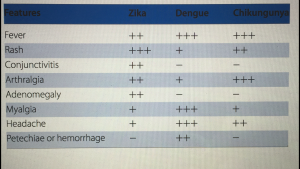The WHO declared a Public Health Emergency of International Concern on February 1st, 2016 due to the outbreak of microcephaly and Guillain-Barre Syndrome cases associated with the Zika virus. Here’s a quick review of what we do and don’t know:
Where is it?
Outbreaks have been seen in Southeast Asia, Africa, and the Pacific Islands. As of May 12th, 2016, the CDC states there are active outbreaks in the Americas, Pacific Islands, and Cape Verde in Africa.
How is it transmitted?
Predominantly through mosquito bites, but also vertically, through sexual contact, and blood transfusions.
How does it present?
Disease course is usually mild and consists of low-grade fever, maculopapular rash, and arthralgias. Complications include congenital microcephaly, fetal losses, Guillain-Barre Syndrome, brain ischemia, myelitis, meningoencephalitis, and death. Differentiating it from other arboviruses can be difficult. The main clinical features distinguishing Zika with Dengue and Chikungunya can be seen in the table below:
How is it Diagnosed and Treated?
Diagnosis is clinical but can be confirmed via RT-PCR or serum antibodies. There is no specific treatment for Zika virus. Symptom management, hydration, and rest is key.
What Don’t We Know?
-Likelihood of acquiring disease if bitten by an infected mosquito
-Frequency of major complications and their risk factors
-When in pregnancy is a maternal infection the most dangerous
-Likelihood of birth defects from maternal infection
References:
1) Bozza, Fernando & Grinsztein, Beatriz. “Key points on Zika infection for the intensivist”. Intensive Care Med. Published Online 12 May 2016
2) LaBeaud, AD. Zika virus infection: An overview. uptodate.com. Accessed 5/17/2016


